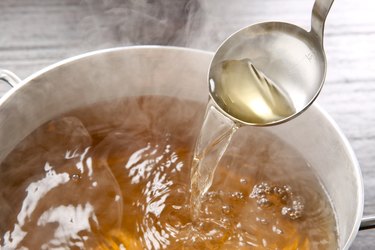
If you've been experiencing the pain of repeated gallbladder attacks, typically a reaction to one or more gallstones blocking the bile duct that leads to the small intestine, the likely conclusion is to have your gallbladder removed. But will that mean your diet has to change too?
Read more: Post-Surgery Gallbladder Diet
Video of the Day
Video of the Day
The Gallbladder's Role in Digestion
The gallbladder is a small organ located beneath your liver that functions as a storage unit for bile — a fluid produced and released by the liver that aids in the digestion of fat, says Johns Hopkins Medicine. After you eat, the gallbladder releases the stored bile via a duct, a tube that connects both your gallbladder and liver to the small intestine. There, bile mixes with the foods you ate and helps process the fats from your meal.
Bile consists mostly of cholesterol, bile salts, bilirubin, water, body salts, copper and other minerals, according to the U.S. National Library of Medicine. However, if there are too many of those elements, they can combine and harden into gallstones, similar to kidney stones.
If a gallstone gets lodged in the bile duct, it can cut off the flow of bile into the small intestine, notes the U.S. National Library of Medicine. The pain you feel is actually your gallbladder trying to push out the stone to clear the route, states Harvard Health Publishing.
"When those gallstones form and the gallbladder becomes blocked, that's when you get pain, and the only way to treat that these days is by removing the gallbladder," explains Michael E. Tarnoff, MD, chair and surgeon-in-chief at Tufts Medical Center and an adjunct associate professor at Tufts University School of Medicine. "It's done through a safe, effective procedure called laparoscopic or minimally invasive cholecystectomy, the medical term for removal of the gallbladder."
Despite the job that the gallbladder is responsible for, Dr. Tarnoff explains that once it's removed, your liver will compensate and your body won't miss the bile storage capacity the gallbladder had provided.
Read more: Foods You Can Eat With Gallstones
Did Diet Do It?
According to the National Institute of Diabetes and Digestive and Kidney Diseases, diet can contribute to gallstones. You may be able to prevent gallstones (or more of them) by eating a diet that's high in fiber. Get it from a wide variety of fruits and vegetables as well as whole-grains such as oats, whole-wheat bread and brown rice.
At the same time, you'll want to cut back on refined carbohydrates, fried foods (especially those dipped in batter) and sweets like pastries and cookies — advice that applies to overall good health too. Limit saturated fats, but eat healthy ones like those in fatty fish and olive oil. In addition, getting regular exercise and maintaining a healthy weight can be beneficial.
Once you have gallstones, diet can't make them disappear, but eating a low-fat diet may help ease symptoms, according to Harvard Health Publishing.
Diet After Gallbladder Removal
First, know that there are no special recipes for people with no gallbladder or a specific "no gallbladder diet."
The most common issue after surgery, affecting 10 to 20 percent of people who've had the surgery, is diarrhea. "That relates to the fact that the bile is circulating through the intestine at a faster rate because you've lost the storage capacity of the gallbladder," says Dr. Tarnoff. "The bile flows through the system and speeds the system up, and that can cause diarrhea."
"That can sometimes be mediated by the diet," he says.
To help you avoid diarrhea as well as possible pain and bloating for the first few days after surgery, the Cleveland Clinic recommends that you:
- Drink clear liquids and a variety of clear broths.
- Start by having gelatin, and then slowly incorporate solid foods.
- Eat small portions to avoid overloading your system.
- Fat calories should be kept at 30 percent of your total daily intake. Skip fatty and fried foods.
- Avoid foods that cause gas, even good-for-you cruciferous vegetables, for awhile.
- Gradually
add back whole grains, nuts, seeds and vegetables.
"When you increase your fiber intake and you increase your water intake, that usually resolves the diarrhea," Dr. Tarnoff says. "And then patients go on and live a normal healthy life and generally have no restrictions in terms of what they should eat."
Read more: List of Foods in the Liquid Diet
- U.S. National Library of Medicine: “Gallbladder Diseases”
- U.S. National Library of Medicine: “Bile”
- Michael E. Tarnoff, MD, chair, surgeon-in-chief, Tufts Medical Center, adjunct associate professor, Tufts University School of Medicine, Boston
- National Institute of Diabetes and Digestive and Kidney Diseases: “What Can I Eat to Prevent Gallstones?”
- Cleveland Clinic: “What to Eat After You Have Your Gallbladder Removed”
- Harvard Health Publishing: “Attack of the Gallstones”
- Johns Hopkins Medicine: "Cholecystitis"
Is this an emergency? If you are experiencing serious medical symptoms, please see the National Library of Medicine’s list of signs you need emergency medical attention or call 911.